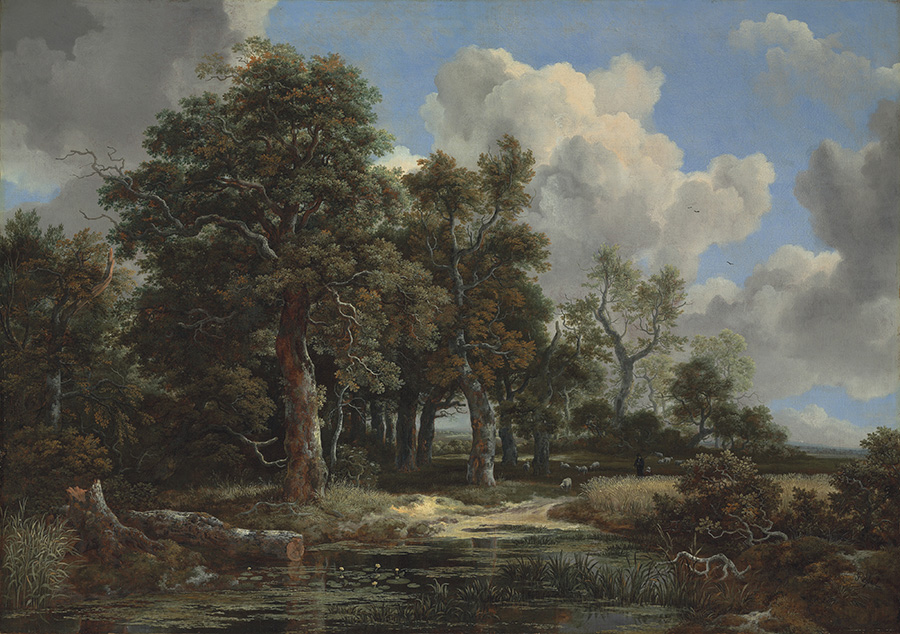
Jacob van Ruisdael, Edge of a Forest with a Grainfield, c. 1656, oil on canvas. Kimbell Art Museum
Explore the first age of globalization through Kimbell Art Museum’s latest exhibition
Dutch Art in a Global Age gives museumgoers a complex view of Dutch dominance in international trade
Art and global history enthusiasts alike will love stepping into what many consider the first age of globalization with the Kimbell Art Museum’s latest exhibition, Dutch Art in a Global Age: Masterpieces from the Museum of Fine Arts, Boston.
Running through Feb. 9, 2025, this showcase delves into the intersection between art, commerce and culture in the Netherlands during the 17th and early 18th centuries.
The exhibition features an array of beautiful paintings and prints by artists like Rembrandt, Frans Hals, Gerrit Dou, Jacob van Ruisdael, Maria Schalcken and more from the Museum of Fine Arts, Boston’s renowned collection.
Combined with several paintings from the Kimbell’s own permanent collection, the exhibition totals more than 125 works of art including paintings, prints, maps, books, porcelain, and metalwork. Together, the pieces offer a comprehensive view of how Dutch dominance in international trade reshaped the Netherlands and sparked an unprecedented cultural flourishing in the 17th century.
“The Museum of Fine Arts, Boston’s collection of Dutch and Flemish masterpieces—and its Center for Netherlandish Art for the study and interpretation of the works—is renowned,” said Eric Lee, director of the Kimbell Art Museum. “We’re grateful to the Boston museum for its generosity in sharing this collection so that audiences can experience its treasures here in Texas.”
The First Age of Globalization Through Art
The 17th century was marked by an economic boom in the Netherlands, driven by international trade. Artists captured the era’s global connections through still lifes, seascapes, cityscapes, and portraits. They depicted imported luxuries like Asian porcelain, Turkish tulips, and American tobacco, along with stirring maritime scenes and vivid landscapes of the Dutch homeland.
The exhibition unfolds across a number of sections that emphasize the global influences on Dutch art:
- The World at Home: Still-life paintings highlight domestic items with international origins, juxtaposed with artifacts like Chinese porcelain, Dutch Delftware, and silver.
- The World Beyond: Grand seascapes and maps celebrate maritime trade, alongside decorative objects collected from global ports.
- Amsterdam as a Cosmopolitan Hub: Paintings portray the capital city as Europe’s busiest port and a cultural epicenter.
- The World of Faith: Sacred art and religious items reflect the enduring influence of faith and Dutch religious tolerance amid global commerce.
- Global Citizens: Portraits reveal the diversity of seventeenth-century Dutch society, exploring the balance between moral ideals and material wealth.
- Celebrating the Familiar: Naturalistic landscapes celebrate the beauty of the Netherlands’ flat, watery terrain.
- Conspicuous Consumption: Genre scenes highlight the material wealth and vanities of Dutch society, featuring paraphernalia for smoking, tea drinking, and the serving of sugar: all of which were made possible through imports from the Americas and Asia.
Acknowledging History’s Complexity
While the exhibition celebrates the artistic achievements of the Dutch Golden Age, it also confronts the darker realities of this prosperity. Visitors will be able to contextualize the era’s art within its historical backdrop, including Dutch colonization and exploitation of trading partners around the world, the Dutch role in the transatlantic slave trade, and the socioeconomic disparities that shaped life in the Netherlands.
Dutch Art in a Global Age offers a thought-provoking journey into the artistry and complexities of a transformative period in history. Don’t miss the chance to explore this remarkable exhibition at the Kimbell Art Museum.
For more information, visit kimbellart.org.
If You Go
Admission to the exhibition is $18 for adults, $16 for seniors and students, $14 for children ages 6–11, and free for children under 6, with half-price admission offered all day on Tuesdays and after 5 p.m. on Fridays.
- Dates: Through Feb. 9, 2025
- Address: Kimbell Art Museum, 3333 Camp Bowie Boulevard, Fort Worth, TX
- Hours: 10 a.m. – 5 p.m. Tuesdays through Thursdays, Saturdays; Noon – 8 p.m. Fridays, Noon – 5 p.m. Sundays; Closed Mondays
- More Info: 817-332-8451 | kimbellart.org
